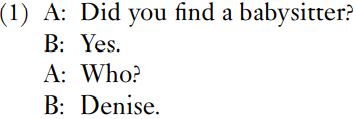
The word and above Phonological units above the syllable
 المؤلف:
April Mc Mahon
المؤلف:
April Mc Mahon
 المصدر:
An introduction of English phonology
المصدر:
An introduction of English phonology
 الجزء والصفحة:
117-10
الجزء والصفحة:
117-10
 21-3-2022
21-3-2022
 1271
1271
Phonological units above the syllable
Native speakers who are not linguists may be slightly surprised by the discovery, that they can count syllables and determine the boundaries between them. However, they will typically be much more consciously aware of the word as a linguistic unit, probably because words are meaningful units; moreover, in a highly literate society, we are familiar with orthographic words, which conveniently appear with white space on each side. Individual spoken or written words can also appear in isolation: three of the four conversational turns in (1) consist, entirely appropriately and comprehensibly, of single words.

However, words, like other linguistic units, are not entirely straightforward and trouble-free for native speakers or for linguists. In particular, there are cases where it is difficult to determine how many words we are dealing with. For example, is washing-machine one word or two? Is it easier or more difficult to decide if we write it as washing machine, without the hyphen? And if we conclude that this is two words, then where does that leave teapot, where two acceptable independent words seem to make up one larger one? It seems that compounds like this take some time to become accepted in the speech community as single words: for a while, they appear as two written words, though signaling one distinct concept semantically (thus, a washing-machine washes clothes, not dishes, for which we have dishwashers, or cars, which go through a carwash). As they are encountered more commonly, they begin to be written with a hyphen, which ultimately drops to leave a single orthographic word – although speakers may think of a compound as a single word before this stage is reached. Conversely, although didn’t, can’t or it’s appear as single written words, speakers will tend to regard these as sequences of two words, contracted by the deletion of a vowel, as signaled by the apostrophe. So, it’s (in It’s Saturday) is a short form of it is, and therefore in a sense two words, as distinct from its (in The cat ate its dinner), which is a single word however you look at it.
For phonological purposes, we can simply note these tricky exceptional cases, and accept that native speakers typically have a good intuitive idea of what a word is (although this is an issue of considerable interest to morphologists). What we are interested in are the phonological properties of words; and the most important of these, in English at least, is stress. As we shall see, although each word has its own characteristic stress pattern when uttered in isolation, words are generally produced in strings, combining into phrases and whole sentences; and phonological processes also operate at these higher levels. First, the position of stress on the isolated word may change when that word forms part of a larger unit; and secondly, some segmental processes, affecting vowels or consonants, may also apply between words.
 الاكثر قراءة في Phonology
الاكثر قراءة في Phonology
 اخر الاخبار
اخر الاخبار
اخبار العتبة العباسية المقدسة


